Assessing the Resilience of Critical Infrastructure Facilities toward a Holistic and Theoretical Approach: A Multi-Scenario Evidence and Case Study
Abstract
:1. Introduction
1.1. Resilience Concept and Infrastructural Resilience Assessment
1.2. Curve-Based Conceptualization for Infrastructure Resilience Assessment
1.3. Background on Road Infrastructure Resilience Assessment
2. Materials and Methods
- First, we conducted a thorough review of the concept of resilience, with a focus on sustainability and the methodologies for assessing critical infrastructure resilience. The following keywords were utilized to search peer-reviewed publications: infrastructure resilience, sustainable infrastructure systems, critical infrastructure, road infrastructure resilience, resilience assessment, and critical infrastructure resilience assessment. These keywords were searched across databases including Web of Science, Scopus, and Google Scholar. A total of 307 research articles, 89 conference papers, and 52 books published between 2010 and 2023 were reviewed. This critical review aimed to understand the current needs and techniques for infrastructure resilience assessment, highlighting gaps in the application of infrastructure resilience, as understanding these existing deficiencies would enable the identification of pathways to contribute to and address the current gaps in the field. Based on the aim of this research, the literature enabled us to further identify critical infrastructure resilience dimensions and their corresponding sustainability factors specifically for roadway infrastructure, allowing us to develop our road infrastructure resilience assessment framework. The distribution of the reviewed publications is depicted in Figure 2.
- We applied a system thinking approach to identify the dimensions and factors that influence road infrastructure resilience, with an emphasis on sustainability. System thinking, which fosters curiosity, humility, and openness to multiple perspectives and possibilities, was applied in a holistic manner to analyze resilience within its environmental context. This approach enabled us to identify and address the fundamental factors of resilience, ensuring that they were aligned with sustainable objectives. Based on this approach, the authors adopted “robustness”—which refers to the ability of an infrastructure to withstand and cope with the occurrence of disasters and resist any negative impacts caused by such events—as a crucial dimension for a resilient road as a standalone infrastructure, as it contributes to the strengthening of the road infrastructure. A resilient road must be robust enough to ensure that its pavement can physically withstand disruptive events. Modern infrastructures must maximize the comfort and safety of users, making it essential for the road infrastructure to be intelligent enough to monitor and control daily climate change and traffic conditions, providing data through an equipped information dissemination system. Thus, the “Intelligence” dimension contributes significantly to the resilience of road infrastructure. “Recoverability” is the ability of road infrastructure to quickly resume operation after being damaged or destroyed.
- The identified factors enabled us to develop and formulate a road infrastructure resilience assessment framework, which was then applied to a case study of a road damaged by a natural disaster in Burundi. The research methods and procedures for this study are detailed in Figure 3.
3. Results
3.1. Novel Infrastructure Resilience Assessment Curve (NIRAC)
NIRAC Explanation
- In the pre-disaster period, the infrastructure operates at its normal performance level, providing maximum service, as expected. During this time, the degree of vulnerability of the system is determined by the threshold of a span angle of 180 degrees. This indicates that the infrastructure has not experienced any disruptions, and its robustness is still undetermined. Therefore, all four considered infrastructure scenarios (A, B, C, and D) are providing their expected services without any issues or disruptions.
- During the occurrence of the event, the performance of the infrastructure in four scenarios (A, B, C, and D) varies based on their behavior against the disaster. Each scenario’s vulnerability level is determined by its state of disruption, along with its level of resistance to providing service. The difference in the vulnerability level is determined by the gap in the vulnerability degree. Therefore, the infrastructure scenario with a direct loss of function due to the occurrence of the events seems more vulnerable and less robust, so the angle between the infrastructure’s initial function and vulnerability level is estimated to be 90° and the climbing vulnerability level is estimated to measure n = 15° from a scenario to another.Note that n = 15° is a random escalation degree between one scenario and another that can change according to the value of the vulnerability level of the scenarios.
- 3.
- The four presented scenarios are deescalated by n = 15°. This means that, if the infrastructure presents a performance which is 15° more than that of another, then it is more robust. Furthermore, the infrastructure in Scenario A, with a vulnerability level of 90°, is less robust than B, measuring about 15° more. So, B’s robustness level threshold is equal to 90° + 15° (90° + n). However, infrastructure Scenario B, with 90° + n, is less robust than infrastructure C, with a resistance curve of 90° + 2n, which is, in turn, less robust than infrastructure system D, whose level of resistance is determined by a span angle of 90° + 3n.
- 4.
- Based on the general definition of infrastructure resilience, which is the ability of an infrastructure to withstand, respond, and recover from the effect of a disruptive event [2,25], this ability is described in function of time and the performance level of the targeted infrastructure. Therefore, a resilience assessment curve, as illustrated in Figure 4 for the recovery aspect, presents a different performance from one scenario to another. The assessment method proves that, the more an infrastructure is robust, the more it will be rapidly repaired or recovered. For this reason, the time between ta and ta’ taken by infrastructure Scenario A (with 90°) to be recovered is too long and requires more resources than the time tb − tb’ taken by infrastructure Scenario B (with 90° + n) to be recovered, and so on. Table 1 summarizes the performance level of each scenario during the disaster and the corresponding impact during the recovery process for each scenario studied.
3.2. Road Infrastructure Resilience Assessment (RIRA) Framework Development
3.2.1. System Thinking Approach for Road Infrastructure Resilience Factor Identification
3.2.2. Road Resilience Factor Analysis
3.2.3. Inter-Relationship between Road Infrastructure Resilience Factors within the Performance Curve
3.2.4. Road Infrastructure Resilience Assessment (RIRA) Framework
3.3. Case Study
3.3.1. National Road 9 Recovery Process
- Visiting the site and identifying the most affected area of road infrastructure;
- Conducting a geotechnical investigation of the affected road area;
- Carrying out an emergency feasibility study regarding the stabilization of threatened points;
- Identifying and quickly mobilizing potential resource needs;
- Following the existing national disaster management and risk reduction plan to successfully restore road traffic in an efficient and speedy manner.
3.3.2. Practical Application and Integration of the RIRA Framework with the Success Performance Factors Implemented for Case Road Recovery
3.3.3. Discussion of the Results
4. Conclusions and Future Works
Author Contributions
Funding
Institutional Review Board Statement
Informed Consent Statement
Data Availability Statement
Acknowledgments
Conflicts of Interest
References
- Argyroudis, S.A.; Mitoulis, S.A.; Hofer, L.; Zanini, M.A.; Tubaldi, E.; Frangopol, D.M. Resilience assessment framework for critical infrastructure in a multi-hazard environment: Case study on transport assets. Sci. Total Environ. 2020, 714, 136854. [Google Scholar]
- Wang, X.; Mazumder, R.K.; Salarieh, B.; Salman, A.M.; Shafieezadeh, A.; Li, Y. Machine learning for risk and resilience assessment in structural engineering: Progress and future trends. J. Struct. Eng. 2022, 148, 03122003. [Google Scholar] [CrossRef]
- Heinimann, H.R.; Hatfield, K. Infrastructure resilience assessment, management and governance–state and perspectives. In Resilience and Risk: Methods and Application in Environment, Cyber and Social Domains; Springer: Dordrecht, The Netherlands, 2017; pp. 147–187. [Google Scholar]
- Pacheco, J.; Tunc, C.; Hariri, S. Design and evaluation of resilient infrastructures systems for smart cities. In Proceedings of the 2016 IEEE International Smart Cities Conference (ISC2), Trento, Italy, 12–15 September 2016; IEEE: New York, NY, USA, 2016; pp. 1–6. [Google Scholar]
- Fath, B.D.; Dean, C.A.; Katzmair, H. Navigating the adaptive cycle: An approach to managing the resilience of social systems. Ecol. Soc. 2015, 20, 24. [Google Scholar] [CrossRef]
- Adobor, H. Supply chain resilience: An adaptive cycle approach. Int. J. Logist. Manag. 2020, 31, 443–463. [Google Scholar] [CrossRef]
- Rogers, C.D.; Bouch, C.J.; Williams, S.; Barber, A.R.; Baker, C.J.; Bryson, J.R.; Chapman, D.N.; Chapman, L.; Coaffee, J.; Jefferson, I.; et al. Resistance and resilience–paradigms for critical local infrastructure. In Proceedings of the Institution of Civil Engineers-Municipal Engineer; Thomas Telford Ltd.: London, UK, 2012; Volume 165, pp. 73–83. [Google Scholar]
- Oswald, M.; Li, Q.; McNeil, S.; Trimbath, S. Measuring infrastructure performance: Development of a national infrastructure index. Public Work. Manag. Policy 2011, 16, 373–394. [Google Scholar] [CrossRef]
- Skorobogatova, O.; Kuzmina-Merlino, I. Transport infrastructure development performance. Procedia Eng. 2017, 178, 319–329. [Google Scholar] [CrossRef]
- Ongkowijoyo, C.S.; Doloi, H. Risk-based resilience assessment model focusing on urban infrastructure system restoration. Procedia Eng. 2018, 212, 1115–1122. [Google Scholar] [CrossRef]
- Murdock, H.J.; De Bruijn, K.M.; Gersonius, B. Assessment of critical infrastructure resilience to flooding using a response curve approach. Sustainability 2018, 10, 3470. [Google Scholar] [CrossRef]
- Goldbeck, N.; Angeloudis, P.; Ochieng, W.Y. Resilience assessment for interdependent urban infrastructure systems using dynamic network flow models. Reliab. Eng. Syst. Saf. 2019, 188, 62–79. [Google Scholar] [CrossRef]
- Poulin Kane Gopalakrishnan, K.; Peeta, S. (Eds.) Sustainable and Resilient Critical Infrastructure Systems: Simulation, Modeling, and Intelligent Engineering; Springer Science & Business Media: Berlin/Heidelberg, Germany, 2010. [Google Scholar]
- Zhang, Y.; Shang, K. Cloud model assessment of urban flood resilience based on PSR model and game theory. Int. J. Disaster Risk Reduct. 2023, 97, 104050. [Google Scholar] [CrossRef]
- Holling, C.S. Resilience and stability of ecological systems. Annu. Rev. Ecol. Syst. 1973, 4, 1–23. [Google Scholar] [CrossRef]
- Berke, P.R.; Campanella, T.J. Planning for postdisaster resiliency. Ann. Am. Acad. Political Soc. Sci. 2006, 604, 192–207. [Google Scholar] [CrossRef]
- Rus, K.; Kilar, V.; Koren, D. Resilience assessment of complex urban systems to natural disasters: A new literature review. Int. J. Disaster Risk Reduct. 2018, 31, 311–330. [Google Scholar] [CrossRef]
- Moser, S.; Meerow, S.; Arnott, J.; Jack-Scott, E. The turbulent world of resilience: Interpretations and themes for transdisciplinary dialogue. Clim. Chang. 2019, 153, 21–40. [Google Scholar] [CrossRef]
- Palekiene, O.; Simanaviciene, Z.; Bruneckiene, J. The application of resilience concept in the regional development context. Procedia-Soc. Behav. Sci. 2015, 213, 179–184. [Google Scholar] [CrossRef]
- Bi, W.; MacAskill, K.; Schooling, J. Old wine in new bottles? Understandingn infrastructure resilience: Foundations, assessment, and limitations. Transp. Res. Part D Transp. Environ. 2023, 120, 103793. [Google Scholar] [CrossRef]
- Cantelmi, R.; Di Gravio, G.; Patriarca, R. Reviewing qualitative research approaches in the context of critical infrastructure resilience. Environ. Syst. Decis. 2021, 41, 341–376. [Google Scholar] [CrossRef]
- Rehak, D.; Senovsky, P.; Hromada, M.; Lovecek, T. Complex approach to assessing resilience of critical infrastructure elements. Int. J. Crit. Infrastruct. Prot. 2019, 25, 125–138. [Google Scholar] [CrossRef]
- Ouyang, M.; Dueñas-Osorio, L.; Min, X. A three-stage resilience analysis framework for urban infrastructure systems. Struct. Saf. 2012, 36, 23–31. [Google Scholar] [CrossRef]
- Franchin, P.; Cavalieri, F. Probabilistic assessment of civil infrastructure resilience to earthquakes. Comput.-Aided Civ. Infrastruct. Eng. 2015, 30, 583–600. [Google Scholar] [CrossRef]
- Abbasi, O.; Noorzai, E.; Gharouni Jafari, K.; Golabchi, M. Exploring the causes of delays in construction industry using a cause-and-effect diagram: Case study for Iran. J. Archit. Eng. 2020, 26, 05020008. [Google Scholar] [CrossRef]
- Gopa Poulin, C.; Kane, M.B. Infrastructure resilience curves: Performance measures and summary metrics. Reliab. Eng. Syst. Saf. 2021, 216, 107926. [Google Scholar] [CrossRef]
- Shafieezadeh, A.; Burden, L.I. Scenario-based resilience assessment framework for critical infrastructure systems: Case study for seismic resilience of seaports. Reliab. Eng. Syst. Saf. 2014, 132, 207–219. [Google Scholar] [CrossRef]
- Hossain, N.U.I.; Jaradat, R.; Hosseini, S.; Marufuzzaman, M.; Buchanan, R.K. A framework for modeling and assessing system resilience using a Bayesian network: A case study of an interdependent electrical infrastructure system. Int. J. Crit. Infrastruct. Prot. 2019, 25, 62–83. [Google Scholar] [CrossRef]
- Davis, C.A. Understanding functionality and operability for infrastructure system resilience. Nat. Hazards Rev. 2021, 22, 06020005. [Google Scholar] [CrossRef]
- Bruneau, M.; Chang, S.E.; Eguchi, R.T.; Lee, G.C.; O’Rourke, T.D.; Reinhorn, A.M.; Von Winterfeldt, D. A framework to quantitatively assess and enhance the seismic resilience of communities. Earthq. Spectra 2003, 19, 733–752. [Google Scholar] [CrossRef]
- Loveček, T.; Sventeková, E.; Mariš, L.; Řehák, D. Determining the resilience of transport critical infrastructure element: Use case. In Proceedings of the 21th International Scientific Conference, Juodkrante, Lithuania, 20–23 September 2017; Volume 3, pp. 824–828. [Google Scholar]
- Calvert, S.C.; Snelder, M. A methodology for road traffic resilience analysis and review of related concepts. Transp. A Transp. Sci. 2018, 14, 130–154. [Google Scholar] [CrossRef]
- Giunta, M. Sustainability and resilience in the rehabilitation of road infrastructures after an extreme event: An integrated approach. Balt. J. Road Bridge Eng. 2017, 12, 154–160. [Google Scholar] [CrossRef]
- Nipa, T.J.; Kermanshachi, S. Dimensions of resilience measurement in critical transportation infrastructure. In Proceedings of the International Conference on Transportation and Development 2021, Virtual, 8–10 June 2021; pp. 302–312. [Google Scholar]
- Aghababaei, M.T.S.; Costello, S.B.; Ranjitkar, P. Measures to evaluate post-disaster trip resilience on road networks. J. Transp. Geogr. 2021, 95, 103154. [Google Scholar] [CrossRef]
- Nipa, T.J.; Kermanshachi, S.; Pamidimukkala, A. Evaluation of Resilience dimensions on Reconstruction of Highway infrastructure projects. J. Leg. Aff. Disput. Resolut. Eng. Constr. 2023, 15, 04522057. [Google Scholar] [CrossRef]
- Shehadeh, A.; Alshboul, O.; Hamedat, O. Risk assessment model for optimal gain–pain share ratio in target cost contract for construction projects. J. Constr. Eng. Manag. 2022, 148, 04021197. [Google Scholar] [CrossRef]
- Rey, D.; Bar-Gera, H. Long-term scheduling for road network disaster recovery. Int. J. Disaster Risk Reduct. 2020, 42, 101353. [Google Scholar] [CrossRef]
- Vugrin, E.D.; Warren, D.E.; Ehlen, M.A. A resilience assessment framework for infrastructure and economic systems: Quantitative and qualitative resilience analysis of petrochemical supply chains to a hurricane. Process Saf. Prog. 2011, 30, 280–290. [Google Scholar] [CrossRef]
- Liu, Z.; Chen, H.; Liu, E.; Hu, W. Exploring the resilience assessment framework of urban road network for sustainable cities. Phys. A Stat. Mech. Appl. 2022, 586, 126465. [Google Scholar] [CrossRef]
- Singhal, T.K.; Kwon, O.S.; Bentz, E.C.; Christopoulos, C. Development of a civil infrastructure resilience assessment framework and its application to a nuclear power plant. Struct. Infrastruct. Eng. 2021, 18, 1–14. [Google Scholar] [CrossRef]
- Guo, D.; Shan, M.; Owusu, E.K. Resilience assessment frameworks of critical infrastructures: State-of-the-art review. Buildings 2021, 11, 464. [Google Scholar] [CrossRef]
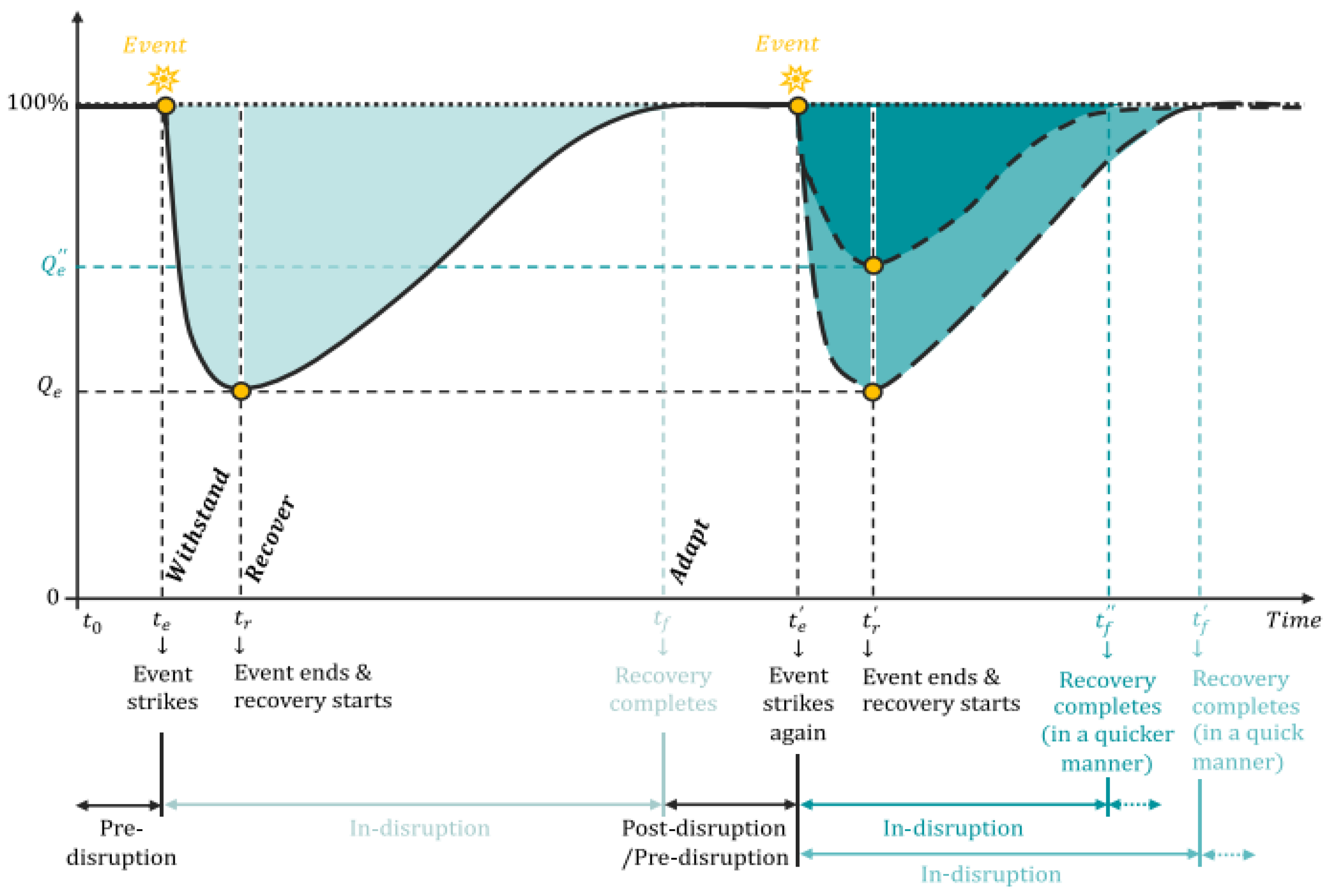
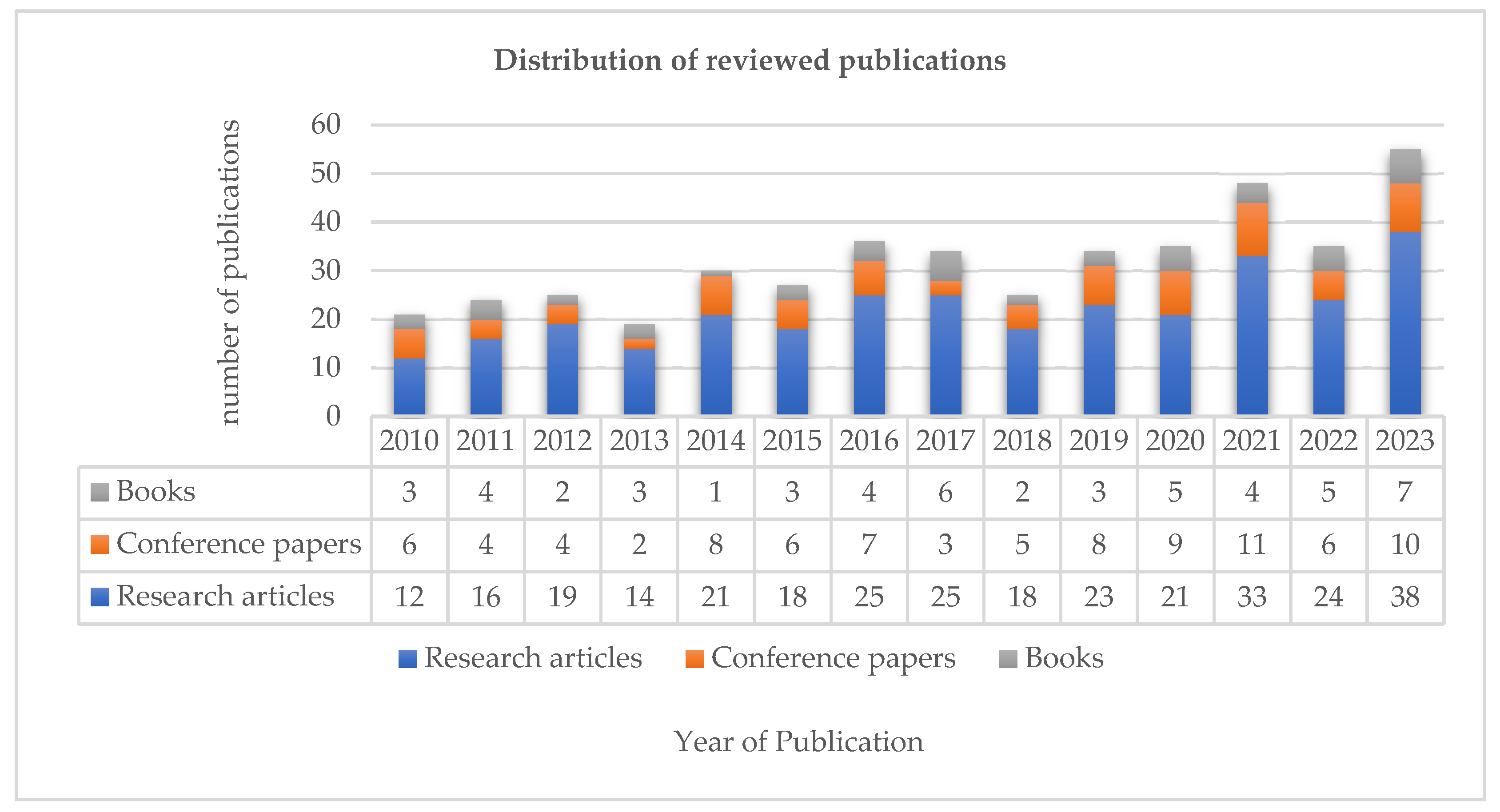
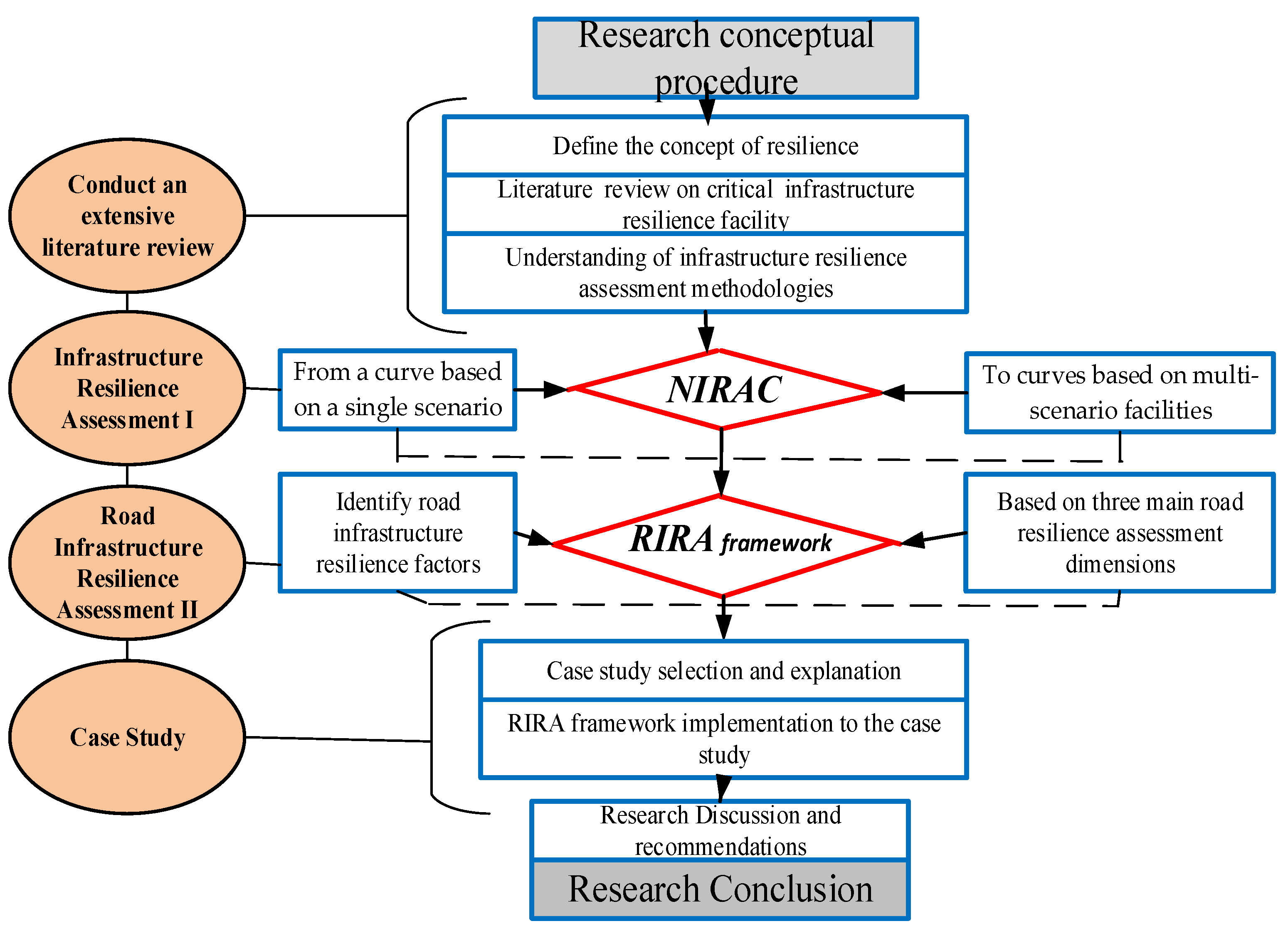
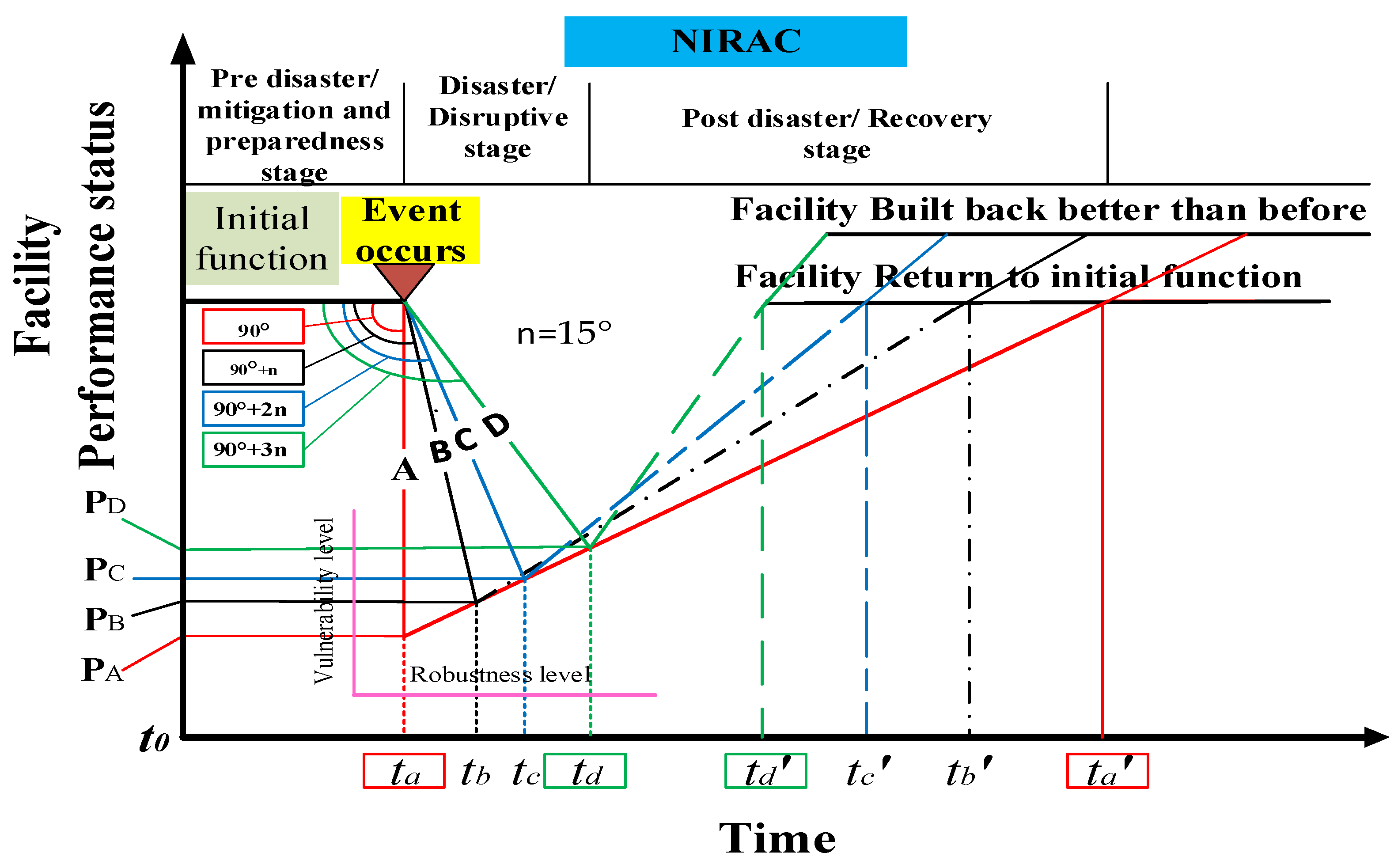

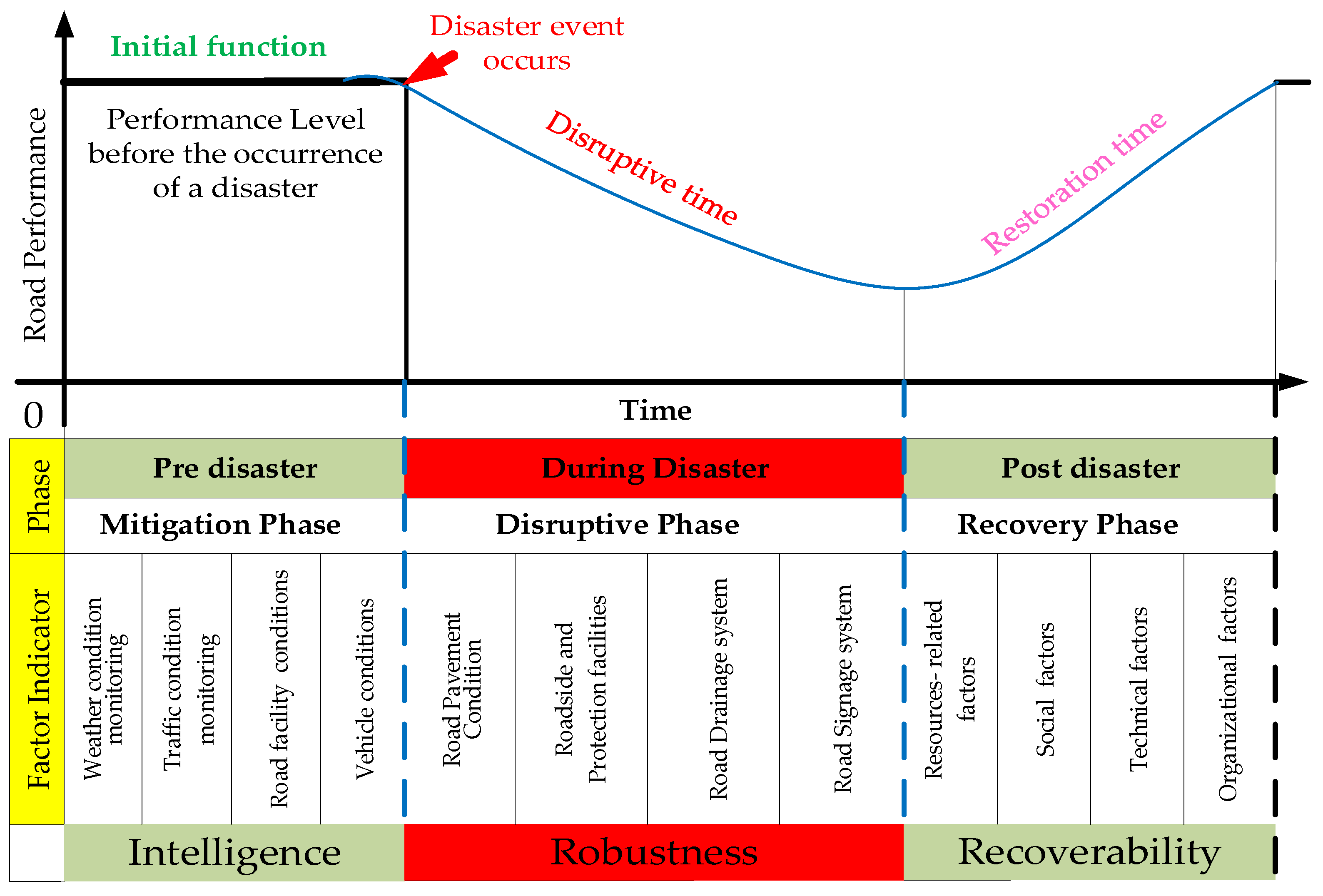
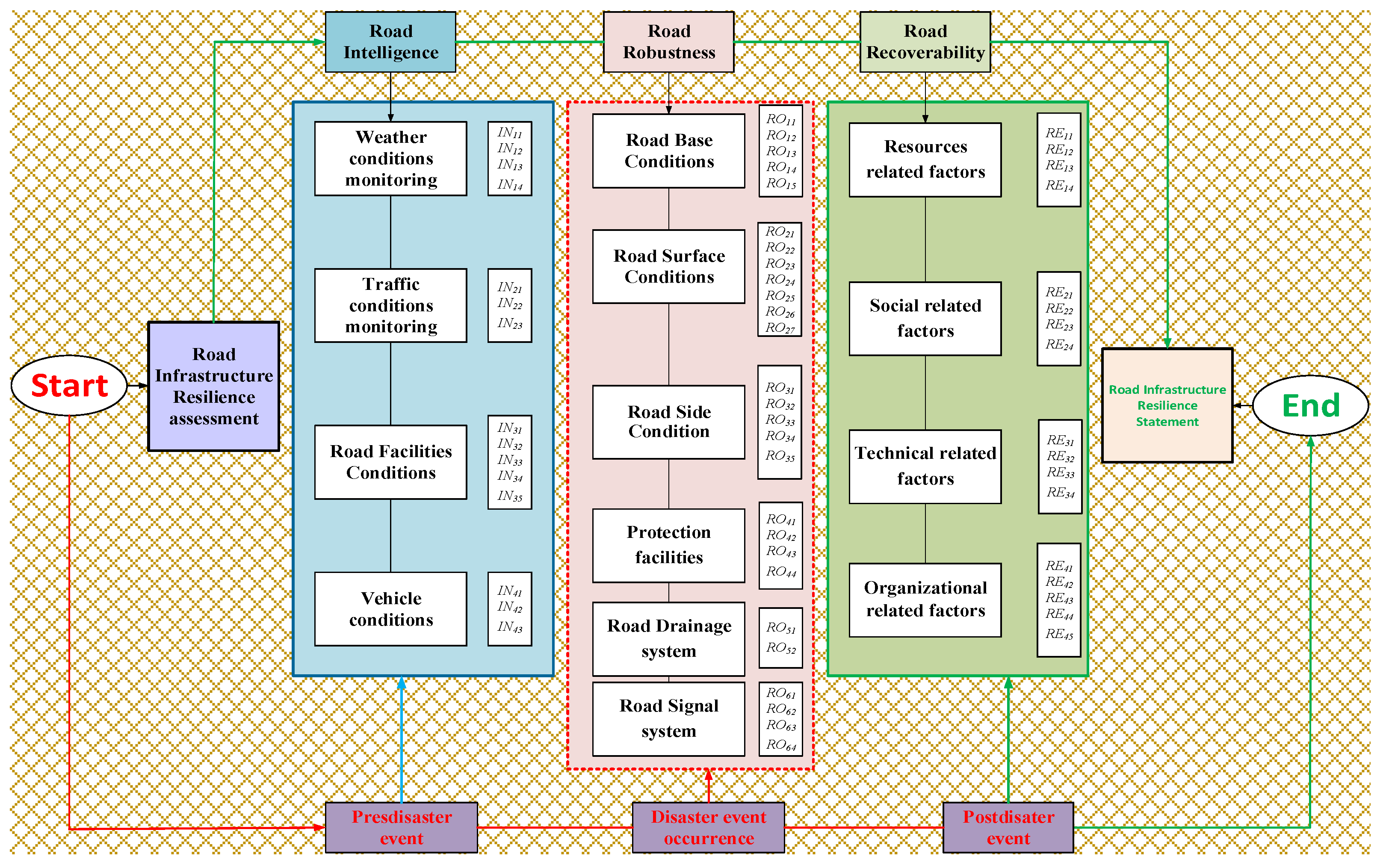
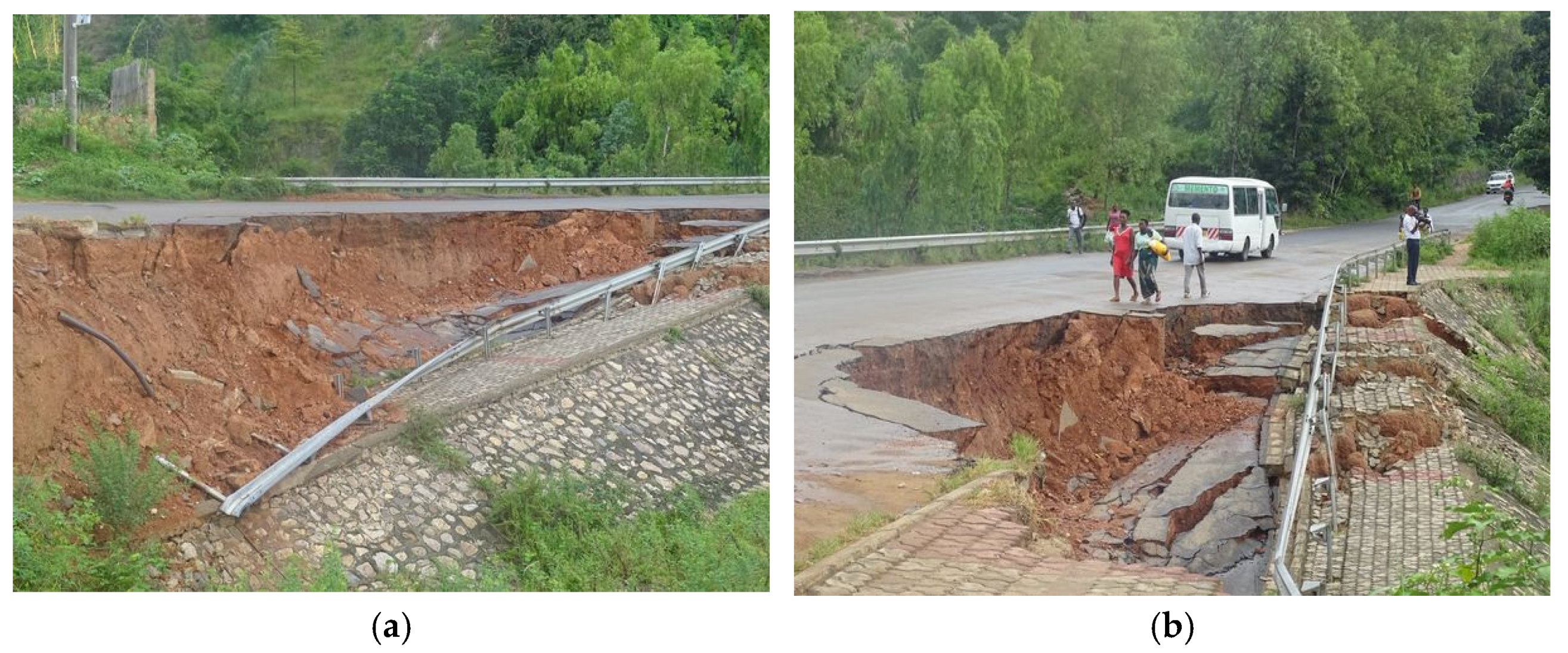
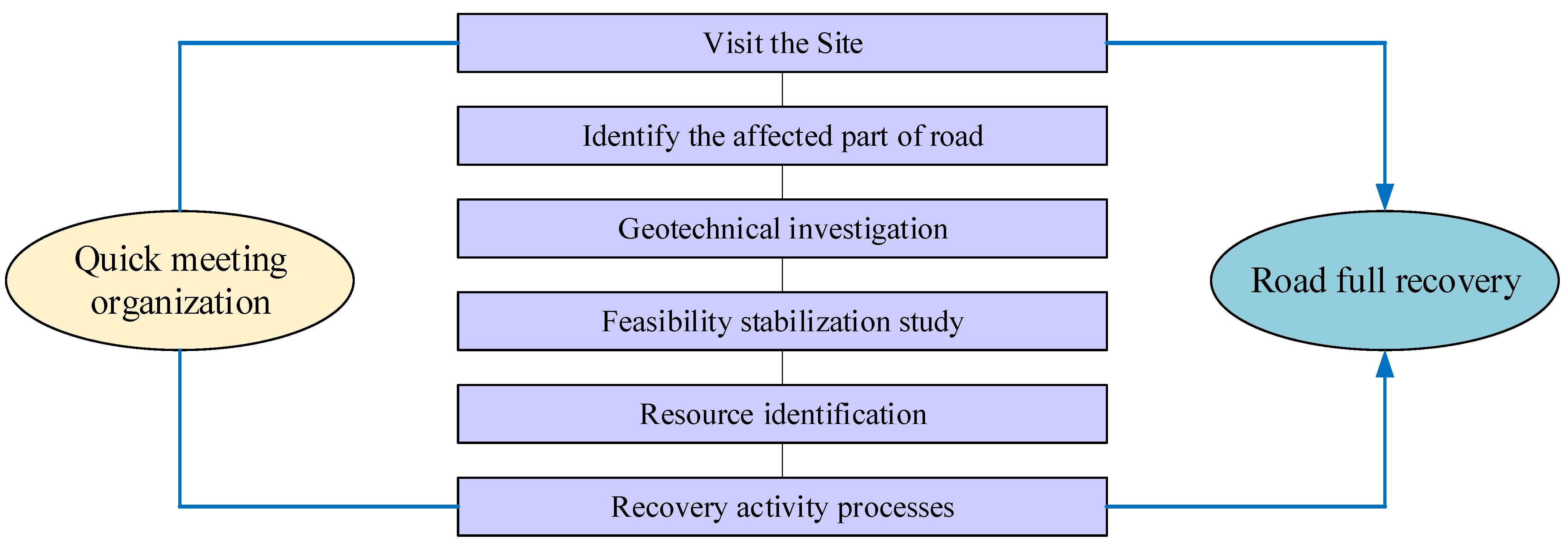

| Scenario | Pre-Disaster Performance | Performance During the Disaster | After-Disaster Status |
|---|---|---|---|
| Scenario A | provides full service | the most vulnerable | high vulnerability, so it requires significant time and resources to be recovered |
| Scenario B | provides full service | less disruption | requires fewer resources and less time for restoration |
| Scenario C | provides full service | greater resilience and more robust | requires a shorter recovery time |
| Scenario D | provides full service | the most resilient and the least disruption | the fastest, the least required resources, and the most robust |
| Dimensions | Indicators | Factors | ID |
|---|---|---|---|
| Road Intelligence | Weather condition monitoring | Wind speed and direction monitoring | IN-11 |
| Rain, storm, snow, fog, and ice monitoring | IN-12 | ||
| High-temperature monitoring | IN-13 | ||
| Thunder and lightning monitoring | IN-14 | ||
| Traffic condition monitoring | Traffic volume and flow congestion monitoring | IN-21 | |
| Traffic crashes/collision monitoring | IN-22 | ||
| Traffic route control | IN-23 | ||
| Road facility conditions | Pavement temperature and humidity monitoring | IN-31 | |
| Road lighting and marking | IN-32 | ||
| Road shape monitoring (slope, curve, etc.) | IN-33 | ||
| Road intersections system | IN-34 | ||
| Vehicle conditions | Vehicle load and motion monitoring | IN-41 | |
| Vehicle mass and noise control | IN-42 | ||
| Vehicle size and speed monitoring | IN-43 |
| Dimension | Indicators | Factors | ID |
|---|---|---|---|
| Road Robustness | Road Pavement Conditions | Soil type conditions (gravel, sand, clay, and silt) | RO-11 |
| Soil property (stiffness or elasticity of the soil) | RO-12 | ||
| Temperature and moisture content | RO-13 | ||
| Roadbed strength and durability | RO-14 | ||
| Degree of compaction/subgrade stabilization | RO-15 | ||
| Construction and material quality | RO-16 | ||
| Surface permeability (void rate) and friction | RO-17 | ||
| Corrosion and drought resistance | RO-18 | ||
| Adhesion degree of aggregate with bitumen | RO-19 | ||
| Skid resistance of surface texture | RO-110 | ||
| Roadside and Protection facilities | Side slope and edge protection | RO-21 | |
| Dust removal system | RO-22 | ||
| Presence of guardrail | RO-23 | ||
| Availability of sidewalk zones | RO-24 | ||
| Roadside vegetation conditions and planting | RO-25 | ||
| Ditch and road embarkment conditions | RO-26 | ||
| Road Drainage System | Roadside and surface drainage | RO-31 | |
| Cross- and sub-surface drainage | RO-32 | ||
| Road Signage System | Road marking condition | RO-41 | |
| Road lighting system | RO-42 | ||
| Installation of RFID system | RO-43 | ||
| Road signs and symbols | RO-44 |
| Dimension | Indicators | Factors | ID |
|---|---|---|---|
| Road Recoverability | Resource-related factors | Availability of fund/budget | RE-11 |
| Skilled and experienced workforce | RE-12 | ||
| Availability of construction materials | RE-13 | ||
| Equipment availability and workability | RE-14 | ||
| Social factors | Local maintenance feasibility | RE-21 | |
| Part-time inspection | RE-22 | ||
| Reporting mechanism | RE-23 | ||
| Land acquisition management | RE-24 | ||
| Technical factors | Rapid design | RE-31 | |
| Prefabricated construction materials | RE-32 | ||
| Traffic diverging | RE-33 | ||
| Alternative route | RE-34 | ||
| Organizational factors | Road recovery processes | RE-41 | |
| Quick decision mechanism | RE-42 | ||
| Special department establishment | RE-43 | ||
| Key stakeholders’ involvement and commitment | RE-44 |
| Road Intelligence-Related Factors | Road Robustness-Related Factors | Road Recoverability-Related Factors | |||||||||
|---|---|---|---|---|---|---|---|---|---|---|---|
| Rank | Mean | SD | p-Value | Rank | Mean | SD | p-Value | Rank | Mean | SD | p-Value |
| IN-12 | 4.83 | 0.391 | 0.000 a | RO-25 | 4.48 | 0.571 | 0.001 a | RE-13 | 4.51 | 0.418 | 0.002 a |
| IN-11 | 4.69 | 0.400 | 0.001 a | RO-41 | 4.41 | 0.585 | 0.001 a | RE-14 | 4.36 | 0.424 | 0.004 a |
| IN-32 | 4.68 | 0.402 | 0.001 a | RO-31 | 4.36 | 0.594 | 0.002 a | RE-21 | 4.24 | 0.456 | 0.007 a |
| IN-13 | 4.62 | 0.406 | 0.002 a | RO-14 | 4.34 | 0.597 | 0.003 a | RE-33 | 4.20 | 0.465 | 0.008 a |
| IN-22 | 4.60 | 0.408 | 0.002 a | RO-21 | 4.32 | 0.600 | 0.003 a | RE-23 | 4.12 | 0.473 | 0.011 a |
| IN-41 | 4.55 | 0.412 | 0.002 a | RO-26 | 4.23 | 0.611 | 0.003 a | RE-32 | 4.12 | 0.473 | 0.011 a |
| IN-21 | 4.36 | 0.436 | 0.004 a | RO-23 | 4.17 | 0.620 | 0.004 a | RE-22 | 3.99 | 0.486 | 0.019 a |
| IN-23 | 4.33 | 0.444 | 0.005 a | RO-17 | 4.12 | 0.633 | 0.005 a | RE-31 | 3.97 | 0.492 | 0.020 a |
| IN-33 | 4.29 | 0.452 | 0.005 a | RO-43 | 4.02 | 0.648 | 0.007 a | RE-24 | 3.92 | 0.499 | 0.022 a |
| IN-14 | 4.23 | 0.463 | 0.006 a | RO-11 | 4.00 | 0.651 | 0.008 a | RE-12 | 3.86 | 0.506 | 0.025 a |
| IN-31 | 4.12 | 0.480 | 0.008 a | RO-44 | 3.96 | 0.656 | 0.009 a | RE-34 | 3.86 | 0.506 | 0.025 a |
| IN-43 | 4.00 | 0.491 | 0.009 a | RO-24 | 3.93 | 0.660 | 0.010 a | RE-42 | 3.84 | 0.510 | 0.030 a |
| IN-34 | 3.99 | 0.498 | 0.022 a | RO-110 | 3.92 | 0.661 | 0.010 a | RE-11 | 3.78 | 0.521 | 0.031 a |
| IN-42 | 3.97 | 0.502 | 0.023 a | RO-32 | 3.91 | 0.667 | 0.010 a | RE-43 | 3.76 | 0.532 | 0.036 a |
| RO-12 | 3.87 | 0.674 | 0.011 a | RE-41 | 3.68 | 0.558 | 0.041 a | ||||
| RO-18 | 3.86 | 0.678 | 0.011 a | ||||||||
| RO-19 | 3.79 | 0.682 | 0.016 a | ||||||||
| RO-13 | 3.77 | 0.686 | 0.017 a | ||||||||
| RO-16 | 3.74 | 0.695 | 0.023 a | ||||||||
| RO-15 | 3.71 | 0.700 | 0.031 a | ||||||||
| RO-42 | 3.68 | 0.704 | 0.033 a | ||||||||
| RO-22 | 3.66 | 0.707 | 0.041 a | ||||||||
| Case Study Recovery Performance Factors | Description | Verification | |
|---|---|---|---|
| 1 | Geotechnical investigation of the affected road area | This consists of laboratory tests and an analysis of the soil characteristics, inquiring about road base and surface conditions (properties, moisture content, porosity, permeability, etc.) | RIRA factors RO11, RO12, RO13, RO14, RO21, RO22, RO23, and RO24 were involved in the road case study soil tests |
| 2 | Road design | The task of designing the road consists of geometric and topographic alignment, presenting the recovered road layout. Thus, road facilities such as drainage and signal systems are presented in this step. | Consequently, RO31, RO32, RO34, RO35, RO41, RO42, RO43, RO44, RO51, RO52, RO64, and IN33 were designed and recovered. |
| 3 | Resource identification and allocation | The Burundi Road Agency (ARB) owns some human (engineers, labor, etc.), financial, equipment (excavation machines, etc.), and material resources. In the case of a shortage of resources, the agency has rental contracts with private agencies working in the construction sector. In addition, Burundi has a laboratory well equipped to carry out the necessary geotechnical studies. During the recovery process of NR9, the necessary resources were available. | Factors RE11, RE12, RE13, and RE14 of the RIRA framework were verified to influence the recovery process of NR9. |
| 4 | Recovery processes and management (organization) | The ARB has staff organized into different departments to manage construction projects in an accurate manner. Thus, project monitoring, site inspection, surveillance, and decision making were carried out well during the recovery of NR9. | Factors RE21, RE22, RE23, RE24, RE41, RE42, RE43, RE44, and RE45 influenced NR9 recovery. |
Disclaimer/Publisher’s Note: The statements, opinions and data contained in all publications are solely those of the individual author(s) and contributor(s) and not of MDPI and/or the editor(s). MDPI and/or the editor(s) disclaim responsibility for any injury to people or property resulting from any ideas, methods, instructions or products referred to in the content. |
© 2024 by the authors. Licensee MDPI, Basel, Switzerland. This article is an open access article distributed under the terms and conditions of the Creative Commons Attribution (CC BY) license (https://creativecommons.org/licenses/by/4.0/).
Share and Cite
Irankunda, G.; Zhang, W.; Fernand, M.; Zhang, J. Assessing the Resilience of Critical Infrastructure Facilities toward a Holistic and Theoretical Approach: A Multi-Scenario Evidence and Case Study. Sustainability 2024, 16, 8735. https://doi.org/10.3390/su16208735
Irankunda G, Zhang W, Fernand M, Zhang J. Assessing the Resilience of Critical Infrastructure Facilities toward a Holistic and Theoretical Approach: A Multi-Scenario Evidence and Case Study. Sustainability. 2024; 16(20):8735. https://doi.org/10.3390/su16208735
Chicago/Turabian StyleIrankunda, Georges, Wei Zhang, Muhirwa Fernand, and Jianrong Zhang. 2024. "Assessing the Resilience of Critical Infrastructure Facilities toward a Holistic and Theoretical Approach: A Multi-Scenario Evidence and Case Study" Sustainability 16, no. 20: 8735. https://doi.org/10.3390/su16208735






